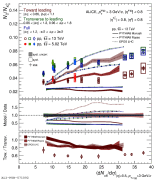Figures from paper submitted to Journal of High Energy Physics
Abstract:
A study of strange hadron production associated with hard scattering processes and with the underlying event is conducted to investigate the origin of the enhanced production of strange hadrons in small collision systems characterised by large charged-particle multiplicities. For this purpose, the production of the single-strange meson ${\rm K^0_S}$ and the double-strange baryon $\Xi^{\pm}$ is measured, in each event, in the azimuthal direction of the highest-$p_{\rm T}$ particle (``trigger" particle), related to hard scattering processes, and in the direction transverse to it in azimuth, associated with the underlying event, in pp collisions at $\sqrt{s}=5.02$ TeV and $\sqrt{s}=13$ TeV using the ALICE detector at the LHC. The per-trigger yields of ${\rm K^0_S}$ and $\Xi^{\pm}$ are dominated by the transverse-to-leading production (i.e., in the direction transverse to the trigger particle), whose contribution relative to the toward-leading production is observed to increase with the event charged-particle multiplicity. The transverse-to-leading and the toward-leading $\Xi^{\pm}$/${\rm K^0_S}$ yield ratios increase with the multiplicity of charged particles, suggesting that strangeness enhancement with multiplicity is associated with both hard scattering processes and the underlying event. The relative production of $\Xi^{\pm}$ with respect to ${\rm K^0_S}$ is higher in transverse-to-leading processes over the whole multiplicity interval covered by the measurement. The ${\rm K}^{0}_{\rm{S}}$ and $\Xi^{\pm}$ per-trigger yields and yield ratios are compared with predictions of three different phenomenological models, namely PYTHIA 8.2 with the Monash tune, PYTHIA 8.2 with ropes and EPOS LHC. The comparison shows that none of them can quantitatively describe either the transverse-to-leading or the toward-leading yields of ${\rm K}^{0}_{\rm{S}}$ and $\Xi^{\pm}$.
JHEP 09 (2024) 204
e-Print: arXiv:2405.14511 | PDF | inSPIRE










